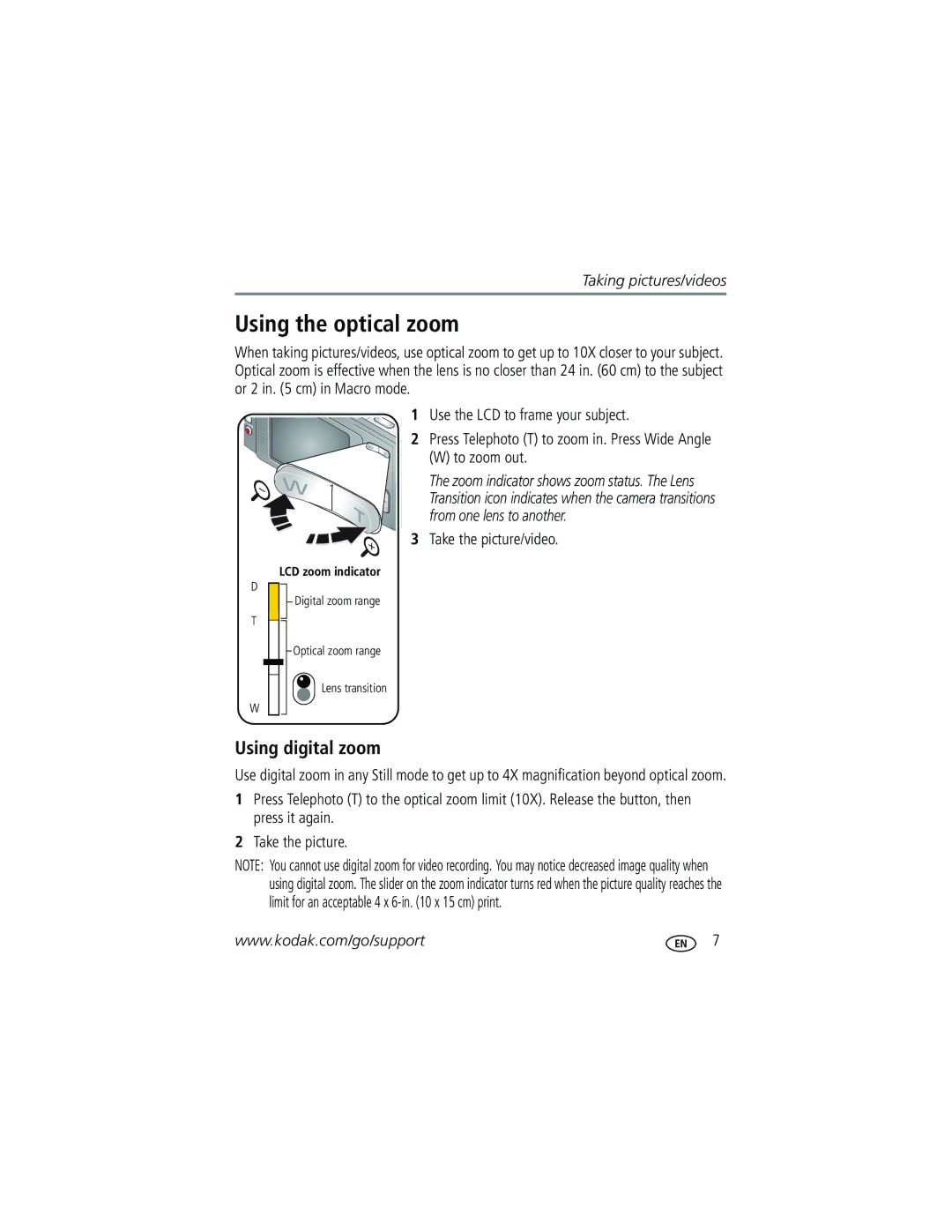Kodak EasyShare V610 dual lens digital camera
Eastman Kodak Company Rochester, New York
Front view
LCD
Back view
Table of contents
Table of contents
Attaching the strap Loading the KLIC-7001 battery
Setting up your camera
Volt AC adapter
Charging the battery
Press the On/Off button to turn the camera on in Auto mode
Setting the language and date/time
Turning on the camera
See page 66 for storage capacities
Storing pictures on an SD or MMC card
Reviewing the picture just taken
Taking a picture
To review pictures/videos anytime, see
Press the Video mode button
Using the framing marks to take pictures
Taking a video
Press the Shutter button halfway
Using digital zoom
Using the optical zoom
Use the LCD to frame your subject
To zoom out
Use the same procedure to take a video, but
Using the self-timer
Off
For flash settings in each mode, see
Using the flash
Light turns green
Using different modes
Using Scene modes
Snow
For Camera pre-settings Night
Beach
Text
Panning
Take the first picture
Taking panoramic pictures
Capture mode-no buttons pressed
Understanding the picture-taking icons
Capture mode-shutter button pressed halfway
Magnifying a picture during review
Reviewing pictures/videos
Playing a video during review
Deleting pictures/videos
Using the undo delete feature
Protecting pictures/videos from deletion
Cropping pictures
Using Kodak Perfect Touch technology
Press the Review button, then to find a picture to crop
OK button
Making a picture from a video
Editing videos
Trimming a video
You can do incredible things with your videos
Running a slide show
Use Slide Show to display your pictures/videos on the LCD
Making a video action print
Starting the slide show
Running a continuous slide show loop
Changing the slide show display interval
Choosing a slide show transition
Displaying pictures/videos on a television
Running a slide show with the photo frame dock
Viewing picture/video information
Viewing pictures/videos in different ways
Viewing by date or by album
Viewing as thumbnails multi-up
Copying pictures/videos
Selecting multiple pictures/videos
Before you copy, make sure that
Copy pictures/videos
Pictures
Understanding the review icons
Videos
White-Print sharpness is not determined
Understanding the blur warning icons
Setting Options Self-timer
Using the menu to change settings
Burst
Video Size
Setting Options Picture Size
White Balance
Black-and-white or sepia
Single AF default for pictures-usesTTL-AF
Setting Options AF Control
Long Time Exposure None default
Reset to Default
Customizing your camera
Auto Power Off Minutes
Seconds default
Off Minutes default Date & Time
Off no dimming
Orientation Sensor On default
Setting Options Auto Picture Rotation On default
Is in Red Eye mode Off-red eye flash does not fire
Playback Blur Warning On default Off
Formatting deletes all
Using exposure compensation to adjust picture brightness
Damage the card
Using the framing grid to compose a picture
Using the histogram to view picture brightness
Sharing your pictures
Printing tagged pictures
Tagging pictures for printing
First-create email addresses
Tagging pictures/videos for emailing
Second-tag pictures/videos on your camera
Press the Share button. Press to find a picture/video
Third-transfer and email
Tagging pictures as favorites
Removing all favorites from your camera
Optional settings
Preventing favorites from transferring to the camera
Printing and emailing favorites
Tagging pictures/videos for albums
First-on your computer
Second-on your camera
Third-transfer to your computer
Pre-tagging for album names
Follow the on-screen instructions to install the software
Installing the software
Using the photo frame dock
Using the USB cable
Transferring pictures/videos
Direct printing with a PictBridge enabled printer
Using other options
Connecting the camera to a PictBridge enabled printer
Printing pictures
Disconnecting the camera from a PictBridge enabled printer
Printing from a PictBridge enabled printer
Turn on the printer. Turn on the camera
Press to choose a printing option, then press the OK button
Dock compatibility for your camera
Using a printer that is not PictBridge enabled
Ordering prints online
Printing from an optional SD or MMC card
Setting up the Bluetooth feature of your camera
Making the set as trusted choice
Set up your camera to trust your devices
Send pictures to a device
Getting the best Bluetooth reception
Send pictures to a printer Send pictures to a computer
Sending pictures to a device
You need a Bluetooth enabled device
Transferring pictures
Before you begin
Receiving pictures from a device
You need a Bluetooth enabled device, such as a cell phone
Sending pictures to a printer
You need a Bluetooth enabled printer
Printing pictures
Sending pictures to a computer
You need a Bluetooth enabled computer
Status Possible Solutions
Camera problems
Troubleshooting
Bluetooth problems
Computer/connectivity problems
Light status Cause
Effective flash range
Picture quality problems
Direct printing PictBridge enabled printer problems
Software
Camera
Other
Getting help
Picture size
Camera specifications
Lens protection-Built-in
ISO speed
Image file format
@ Auto ISO
Quickview-Yes Video output-NTSC or PAL
Tripod mount-1/4 inch Operating temperature-32-104F 0-40C
Flash settings in each mode
Picture storage capacity
Storage capacities
Video storage capacity
Number of pictures Internal memory
Using this product
Important safety instructions
Battery safety and handling
When removing the battery, allow it to cool it may be hot
Extending battery life
Battery replacement, battery life
Limited warranty
Warranty
Limited warranty coverage
Your rights
Limitations
Outside the United States and Canada
Regulatory compliance
FCC compliance and advisory
Canadian DOC statement
Vcci Class B ITE Korean Class B ITE
Co-location statement for Portable NON SAR test
Industry Canada RSS-Gen Issue
FCC Part 15
FCC Part15 Subpart C 15.19a3
China Taiwan Brazil
Country-specific statements
Mexico Coftel
UAE Dubai Israel
Index
Bluetooth
Downloading pictures
Transfer to, 43 connector, USB / A/V, 22, 44 copy pictures
Fireworks
Icon
Kodak EasyShare software installing, 43 upgrading
About pictures, videos, 24 installing
LCD/Info button, ii lens Cleaning lens, 69 lenses
Language
Quickview, using
Power off, 33 printer dock, 45 printing From a card
Running slide show
Scene button
Picture-taking mode
Auto-focus Slide show Bluetooth
Picture quality, 28
Upgrading software, firmware URLs, Kodak Web sites
Deleting

